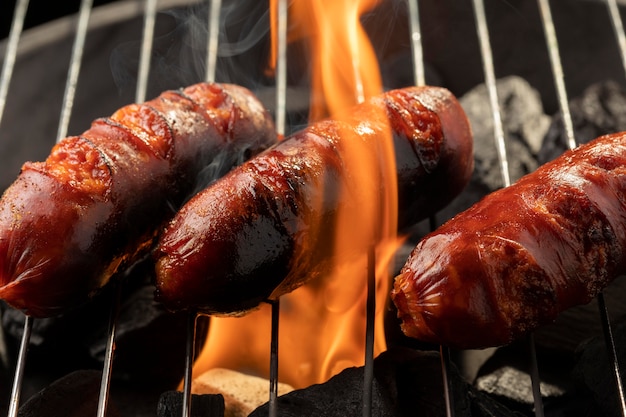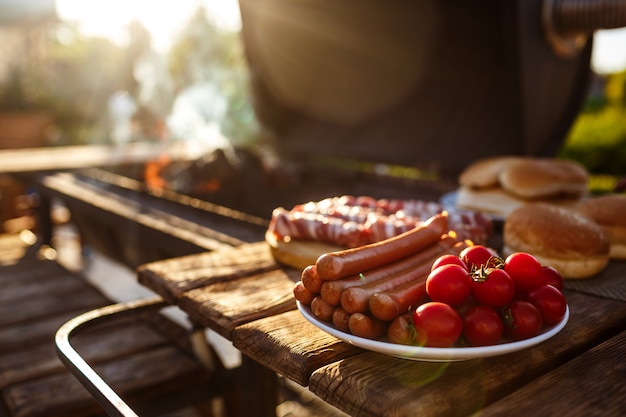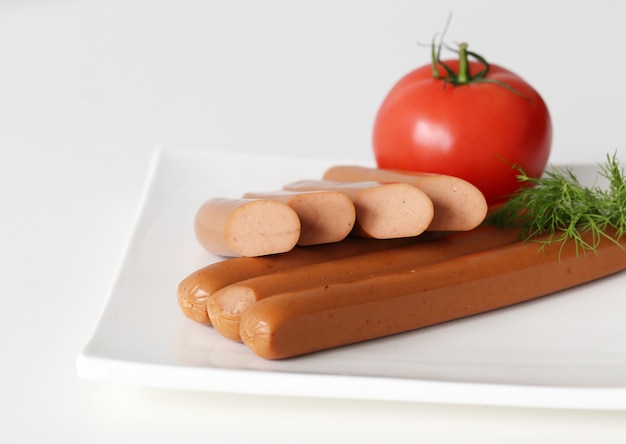You’re standing at your stove, a pack of sausages in hand, and a question pops into your head: How long do I cook these things? It’s a question that’s plagued many a cook, myself included. You want those sausages perfectly cooked, juicy, and bursting with flavour. No one wants dry, rubbery, or worse, undercooked sausages. So, let’s dive into the world of sausage cooking and demystify the art of getting them just right on the stovetop.
(Part 1) Why perfect sausage Cooking Matters

It’s not just about avoiding a culinary catastrophe; it’s about unleashing the full potential of your sausages. Perfect sausage cooking is an art form, one that involves understanding the nuances of heat, time, and the specific characteristics of each sausage type.
The Delights of a Well-Cooked Sausage
Imagine sinking your teeth into a sausage, its skin a delightful crunch, giving way to a juicy, flavorful interior. That’s the magic of perfectly cooked sausages. They’re a symphony of textures and tastes, a true culinary delight.
The Perils of Overcooking
Overcooked sausages, on the other hand, are a culinary crime. They become tough, dry, and lose their delicious flavour. You end up with a rubbery, sad excuse for a sausage. It’s a tragedy, really.
Undercooked Sausages: A Culinary No-No
And then there’s the dreaded undercooked sausage. It’s a health hazard, and let’s face it, nobody wants to be the one serving up raw meat. It’s not a good look.
So, as you can see, getting the cooking time right is crucial. It’s all about finding that sweet spot between undercooked and overcooked, where your sausages achieve culinary bliss.
(Part 2) Unpacking the Factors That Influence Cooking Time

Think of cooking time as a puzzle, one where different pieces need to fit together to create the perfect picture. In this case, we’re talking about the factors that influence how long it takes to cook a sausage on the stovetop.
1. Sausage Type: A World of Flavors
Just like every person is unique, so is every sausage. There’s the classic pork sausage, the bolder beef sausage, the spicy chorizo, and the italian sausage, each with its own distinct flavour profile and cooking characteristics. The type of sausage you’re using will heavily influence the cooking time. Thick, meaty sausages, for instance, will require longer than thinner, more delicate ones.
2. Size Matters: From Tiny to Mammoth
The size of the sausage is another key factor. Those little mini sausages will cook up faster than their larger counterparts. Think of it as a surface area issue. The bigger the surface area, the longer it takes for the heat to penetrate and cook the sausage thoroughly.
3. The Power of Heat: High or Low?
The heat level of your stovetop also plays a crucial role. High heat can be your best friend or your worst enemy. While it helps achieve that crispy, golden-brown exterior, it can also lead to uneven cooking and burnt sausages. Medium-high heat is often the sweet spot, allowing for browning without scorching the interior.
4. The Pan: A Culinary Stage
The pan you choose can also influence the cooking process. A cast iron pan, known for its excellent heat distribution, is a favourite among sausage aficionados. However, any heavy-bottomed pan will do the trick. But remember, a crowded pan will steam your sausages instead of browning them nicely, so give them some breathing room.
5. Sausage Quantity: A Culinary Balancing Act
The number of sausages you're cooking also matters. A small batch will cook faster than a large batch. It's all about the heat distribution and how long it takes for all those sausages to reach the desired internal temperature.
(Part 3) Mastering the Stovetop Sausage Cooking Process

Now that we've explored the key factors influencing cooking time, let’s break down the process of cooking sausages on the stovetop, step-by-step.
1. Prepping for Success: Sausage and Pan
Before you even think about turning on the stove, get those sausages ready. Let them hang out at room temperature for about 15-20 minutes. This helps them cook more evenly and prevents cold spots, which can lead to uneven cooking. While the sausages are getting cozy, get your pan heated. Medium-high heat is your friend.
2. The Sizzling Start: Adding Sausages to the Pan
Once your pan is hot, gently place those sausages in, giving them some space to breathe. Resist the urge to poke or prod them. Let them sizzle and brown beautifully. This is where the magic happens, creating that mouthwatering crispy skin we all love. After a few minutes, give them a good flip and let the other side bask in the heat.
3. Monitoring the Cooking Progress: A Culinary Watchful Eye
This is where your culinary intuition comes into play. Keep a watchful eye on your sausages. As they cook, you'll see juices bubbling out, a sign they're getting close to being done. But don’t forget, we’re aiming for that sweet spot of cooked through, not dried out.
4. Checking for Doneness: The Ultimate Test
Now comes the moment of truth: checking if your sausages are cooked through. The best way to ensure perfection is with a meat thermometer. You want your sausages to reach an internal temperature of 160°F (71°C). If you don't have a meat thermometer, you can use a few other methods. Pierce a sausage with a knife. If the juices run clear and the sausage feels firm, it's likely cooked. You can also use the squeeze test: A firm, springy sausage is cooked through, while a soft, mushy one needs more time.
(Part 4) Sausage Variety and Cooking Time: A Guide
Let’s get specific. Here’s a guide to approximate cooking times for different types of sausages. Remember, these are just guidelines. Always check the packaging for specific instructions, and adjust based on the thickness of your sausages and the heat of your stove.
1. Pork Sausage: A Classic Choice
pork sausages, known for their versatility, are often lean and cook relatively quickly.
- Small pork sausages: 8-10 minutes
- Large pork sausages: 12-15 minutes
2. Beef Sausage: Rich and Flavorful
beef sausages, with their richer flavour profile, tend to take a bit longer to cook, especially if they’re thick.
- Small beef sausages: 10-12 minutes
- Large beef sausages: 15-20 minutes
3. Italian Sausage: A Culinary Delight
Italian sausage, a blend of pork and spices, is a delicious addition to any meal. Its leaner nature makes it cook relatively quickly.
- Small Italian sausages: 10-12 minutes
- Large Italian sausages: 15-18 minutes
4. Chorizo: A Burst of Spanish Flavour
Chorizo, a Spanish sausage known for its intense flavour and bright red colour, often requires a slightly shorter cooking time.
- Small chorizo: 8-10 minutes
- Large chorizo: 10-12 minutes
(Part 5) Beyond Simple Sausage: Elevating Your Culinary Game
Sometimes, a simple sausage just isn't enough. You want to create a whole symphony of flavors and textures, a culinary masterpiece. Let's explore ways to elevate your sausage game by adding other ingredients to the pan.
1. Sausages and Onions: A Classic Duo
Start with those sausages, cooking them as usual. Then, add some sliced onions to the pan. Let them cook with the sausages, softening and caramelizing as they soak up the delicious juices. This adds a sweet and savory dimension to your meal. A dash of red wine vinegar adds a tangy twist, taking your dish to the next level.
2. Sausages and Peppers: A Burst of Colour and Flavour
Slice up some bell peppers, any colour you fancy, and toss them into the pan with your sausages. Let them cook until softened and slightly charred, adding a smoky, irresistible flavour. A sprinkle of garlic and herbs elevates this dish to new heights.
3. Sausages and Mushrooms: Earthy Delights
For a hearty and satisfying meal, add sliced mushrooms to the pan with your sausages. Cook them until tender and golden brown, infusing your dish with a rich, earthy flavour. A splash of white wine or chicken stock adds another layer of complexity, creating a delicious sauce for your sausages and mushrooms.
(Part 6) Tips and Tricks: Mastering the Art of Sausage Cooking
Cooking sausages can sometimes feel like a bit of a culinary gamble, even with all the advice in the world. But fret not! Here are a few more tips and tricks to help you cook those sausages like a seasoned pro.
1. Don't Overcrowd the Pan: Sausages Need Room to Breathe
Remember, we want those sausages to brown beautifully, not steam. Give them ample space in the pan so they can cook evenly on all sides. If you're cooking a large batch, cook them in smaller batches.
2. Embrace the Meat Thermometer: Your Culinary Ally
The meat thermometer is your trusty sidekick, ensuring your sausages are cooked through without overdoing it. It’s especially useful for thicker or denser sausages. Just insert the thermometer into the thickest part of the sausage and watch it reach that magical 160°F (71°C).
3. Patience is Key: Don't Poke or Prod
Allow those sausages to cook peacefully, undisturbed for a few minutes on each side. Poking and prodding them can cause them to lose moisture, leading to dry and unappetizing sausages. Resist the urge to check on them too frequently.
4. The Power of Heat Control: Finding the Sweet Spot
Too high, and you’ll end up with burnt sausages. Too low, and they’ll take forever to cook. Aim for medium-high heat and adjust as needed. You can reduce the heat slightly towards the end of the cooking time to prevent those sausages from drying out.
5. Rest and Relaxation: Let Your Sausages Breathe
After your sausages have reached culinary perfection, let them rest for a few minutes before serving. This allows the juices to redistribute, resulting in more tender and juicy sausages. While they’re resting, you can get started on your sides, like mashed potatoes or green beans.
(Part 7) Leftover Sausage: Storing and Reheating Tips
You’ve cooked up a batch of delicious sausages, and you have leftovers. No problem! Let's explore how to store and reheat them properly.
1. Storing Leftover Sausages: Keeping Them Fresh and Flavorful
Once your sausages have cooled down, store them in an airtight container in the fridge for up to 3-4 days. It's best to store them separately from other foods to prevent cross-contamination. You can also freeze them for longer storage, but remember to defrost them completely before reheating. To freeze, simply place them in a freezer-safe bag or container and freeze for up to 2-3 months.
2. Reheating Leftover Sausages: Restoring Their Culinary Glory
There are a few ways to reheat leftover sausages. You can reheat them in the oven, the microwave, or on the stovetop. To reheat in the oven, preheat your oven to 350°F (175°C). Place your sausages on a baking sheet and bake for 10-15 minutes, or until heated through. To reheat in the microwave, place your sausages on a microwave-safe plate and microwave for 1-2 minutes, or until heated through. To reheat on the stovetop, simply add your sausages to a pan with a little bit of oil and heat over medium heat until they're heated through.
(Part 8) FAQs: Answering Your Sausage Cooking Questions
Here are some of the most common questions I get about cooking sausages on the stovetop. Let’s clear up any lingering doubts and get you cooking with confidence!
1. Those Pesky Sticking Sausages: A Common Culinary Dilemma
Don't worry, we've all been there! The key is to make sure your pan is nice and hot before adding the sausages. If they're sticking, gently loosen them with a spatula. If they're really stuck, add a little bit of oil to the pan. Using a non-stick pan can also help prevent sticking.
2. Oven Cooking: A Sausage Alternative
You can definitely cook sausages in the oven. Simply preheat your oven to 375°F (190°C). Place the sausages on a baking sheet and bake for 20-25 minutes, or until cooked through. Turn them over halfway through cooking for even browning.
3. Sausage Sidekicks: A World of Flavorful Possibilities
Sausages are incredibly versatile! You can pair them with almost any side dish. Some classics include mashed potatoes, mashed swede, green beans, peas, onion gravy, apple sauce, and roasted vegetables. Get creative and experiment to find your favourites!
4. Skin On or Off: A Matter of Preference
It's entirely up to you! Some people prefer to remove the skin before cooking, while others leave it on. Removing the skin will result in a slightly less crispy sausage, but it's still delicious. If you're leaving the skin on, make sure to pierce it a few times with a fork before cooking to prevent the sausage from bursting.
5. Keeping Sausages Moist: A Culinary Secret
There are a couple of things you can do. Firstly, don't overcook them! Cook them until they're just cooked through, and then remove them from the heat. Secondly, you can add a little bit of liquid to the pan, like water, stock, or wine. This will help to create steam, which will help to keep the sausages moist.
And there you have it! I hope this guide has given you all the information you need to cook sausages on the stovetop with confidence. Remember, it's all about practice and a little bit of experimentation. So get in the kitchen, fire up the stove, and get those sausages sizzling!
Everyone is watching

Corn on the Cob: The Ultimate Guide to Perfectly Cooked Ears
Healthy MealsAh, corn on the cob. Just the name evokes images of sunny days, barbecues, and that sweet, juicy flavour that ...

Scallops: The Ultimate Guide to Perfect Cooking
Healthy MealsAh, scallops. Those delicate, sweet, and utterly delicious morsels of the sea. They hold a special place in my...

Spaghetti Squash: The Ultimate Guide to Cooking and Serving
Healthy MealsRemember that time you saw spaghetti squash at the supermarket, looking all bumpy and strange, and thought, "W...

Salmon Cooking Times: Perfect Guide for Every Recipe
Healthy MealsLet me tell you, cooking salmon is an art form. It's all about getting that perfect balance: juicy and tender,...

Ham Cooking Time: How Long to Bake, Smoke, or Boil a Delicious Ham
Healthy MealsAh, ham. It's a classic, isn't it? A real crowd-pleaser, especially around holidays. And when done right, it'...
